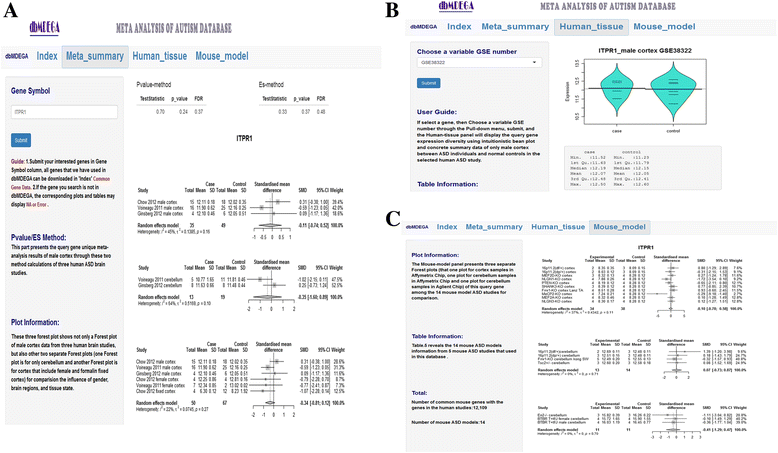dbMDEGA: a database for meta-analysis of differentially expressed genes in autism spectrum disorder
- PMID: 29145823
- PMCID: PMC5691387
- DOI: 10.1186/s12859-017-1915-2
dbMDEGA: a database for meta-analysis of differentially expressed genes in autism spectrum disorder
Abstract
Background: Autism spectrum disorders (ASD) are hereditary, heterogeneous and biologically complex neurodevelopmental disorders. Individual studies on gene expression in ASD cannot provide clear consensus conclusions. Therefore, a systematic review to synthesize the current findings from brain tissues and a search tool to share the meta-analysis results are urgently needed.
Methods: Here, we conducted a meta-analysis of brain gene expression profiles in the current reported human ASD expression datasets (with 84 frozen male cortex samples, 17 female cortex samples, 32 cerebellum samples and 4 formalin fixed samples) and knock-out mouse ASD model expression datasets (with 80 collective brain samples). Then, we applied R language software and developed an interactive shared and updated database (dbMDEGA) displaying the results of meta-analysis of data from ASD studies regarding differentially expressed genes (DEGs) in the brain.
Results: This database, dbMDEGA ( https://dbmdega.shinyapps.io/dbMDEGA/ ), is a publicly available web-portal for manual annotation and visualization of DEGs in the brain from data from ASD studies. This database uniquely presents meta-analysis values and homologous forest plots of DEGs in brain tissues. Gene entries are annotated with meta-values, statistical values and forest plots of DEGs in brain samples. This database aims to provide searchable meta-analysis results based on the current reported brain gene expression datasets of ASD to help detect candidate genes underlying this disorder.
Conclusion: This new analytical tool may provide valuable assistance in the discovery of DEGs and the elucidation of the molecular pathogenicity of ASD. This database model may be replicated to study other disorders.
Keywords: Database; Gene expression; Meta-analysis; Microarray.
Conflict of interest statement
Ethics approval and consent to participate
Not applicable.
Consent for publication
Not applicable.
Competing interests
The authors declare that they have no competing interests.
Publisher’s Note
Springer Nature remains neutral with regard to jurisdictional claims in published maps and institutional affiliations.
Figures


Similar articles
-
Integrated genome-wide Alu methylation and transcriptome profiling analyses reveal novel epigenetic regulatory networks associated with autism spectrum disorder.Mol Autism. 2018 Apr 16;9:27. doi: 10.1186/s13229-018-0213-9. eCollection 2018. Mol Autism. 2018. PMID: 29686828 Free PMC article.
-
Hierarchical cortical transcriptome disorganization in autism.Mol Autism. 2017 Jun 21;8:29. doi: 10.1186/s13229-017-0147-7. eCollection 2017. Mol Autism. 2017. PMID: 28649314 Free PMC article.
-
Integrative analysis of transcriptome-wide association study and mRNA expression profiles identifies candidate genes associated with autism spectrum disorders.Autism Res. 2019 Jan;12(1):33-38. doi: 10.1002/aur.2048. Epub 2018 Dec 18. Autism Res. 2019. PMID: 30561910
-
VariCarta: A Comprehensive Database of Harmonized Genomic Variants Found in Autism Spectrum Disorder Sequencing Studies.Autism Res. 2019 Dec;12(12):1728-1736. doi: 10.1002/aur.2236. Epub 2019 Nov 9. Autism Res. 2019. PMID: 31705629 Review.
-
Neural Transcriptomic Analysis of Sex Differences in Autism Spectrum Disorder: Current Insights and Future Directions.Biol Psychiatry. 2022 Jan 1;91(1):53-60. doi: 10.1016/j.biopsych.2020.11.023. Epub 2020 Dec 7. Biol Psychiatry. 2022. PMID: 33551190 Review.
Cited by
-
RNA sequencing of identical twins discordant for autism reveals blood-based signatures implicating immune and transcriptional dysregulation.Mol Autism. 2019 Nov 7;10:38. doi: 10.1186/s13229-019-0285-1. eCollection 2019. Mol Autism. 2019. PMID: 31719968 Free PMC article.
-
Placental DNA methylation levels at CYP2E1 and IRS2 are associated with child outcome in a prospective autism study.Hum Mol Genet. 2019 Aug 15;28(16):2659-2674. doi: 10.1093/hmg/ddz084. Hum Mol Genet. 2019. PMID: 31009952 Free PMC article.
-
The Relevance of Variants With Unknown Significance for Autism Spectrum Disorder Considering the Genotype-Phenotype Interrelationship.Front Psychiatry. 2019 Jun 7;10:409. doi: 10.3389/fpsyt.2019.00409. eCollection 2019. Front Psychiatry. 2019. PMID: 31231258 Free PMC article. Review.
-
Genomic insights and advanced machine learning: characterizing autism spectrum disorder biomarkers and genetic interactions.Metab Brain Dis. 2024 Jan;39(1):29-42. doi: 10.1007/s11011-023-01322-3. Epub 2023 Dec 28. Metab Brain Dis. 2024. PMID: 38153584 Free PMC article.
-
A Next Generation Sequencing-Based Protocol for Screening of Variants of Concern in Autism Spectrum Disorder.Cells. 2021 Dec 21;11(1):10. doi: 10.3390/cells11010010. Cells. 2021. PMID: 35011571 Free PMC article.
References
-
- Diagnostic and statistical manual of mental disorders DSM-5. Arlington, VA: American Psychiatric Association. 2015. http://dsm.psychiatryonline.org. Accessed 12 April 2015.
Publication types
MeSH terms
Grants and funding
LinkOut - more resources
Full Text Sources
Other Literature Sources
Medical

